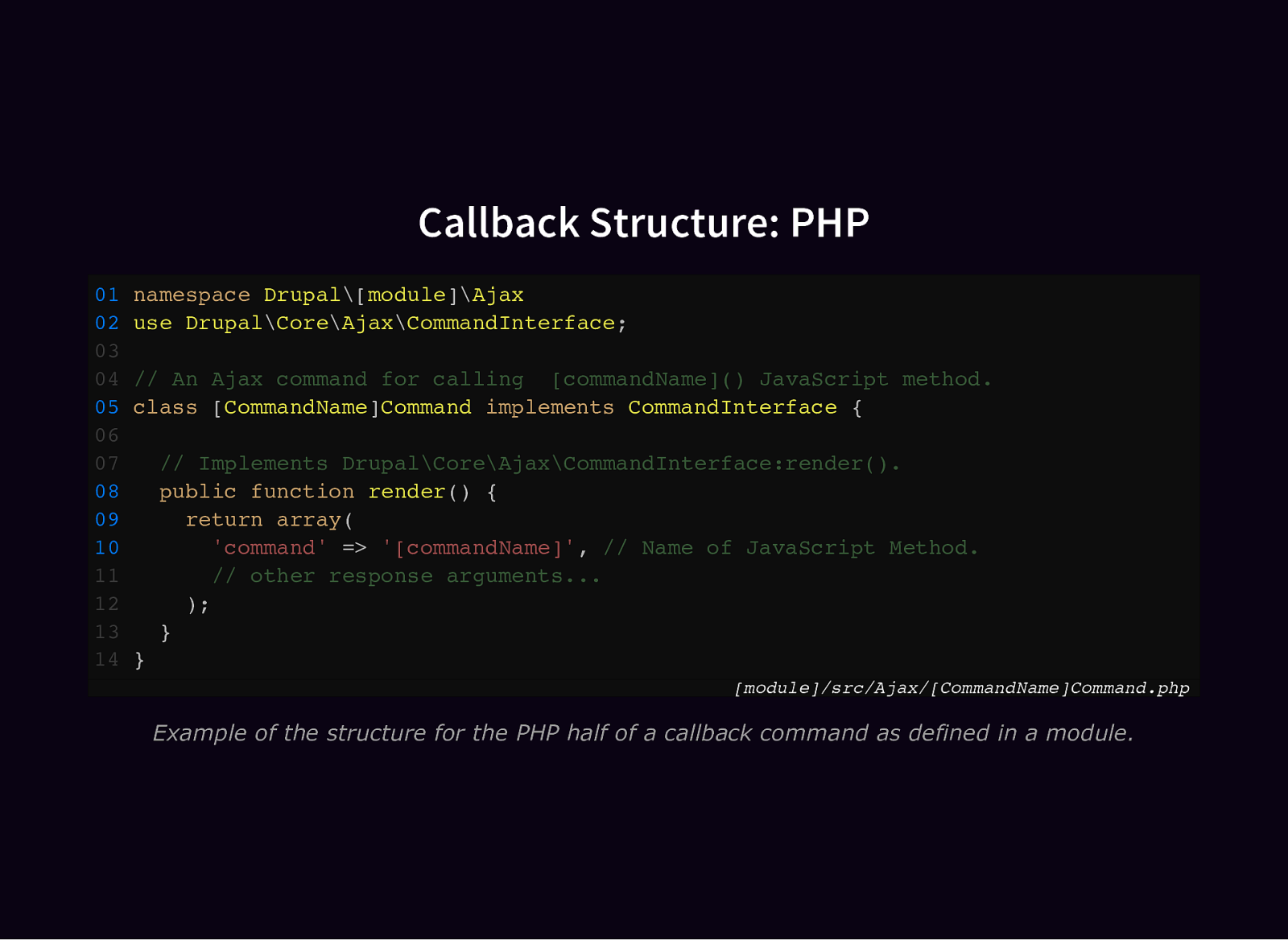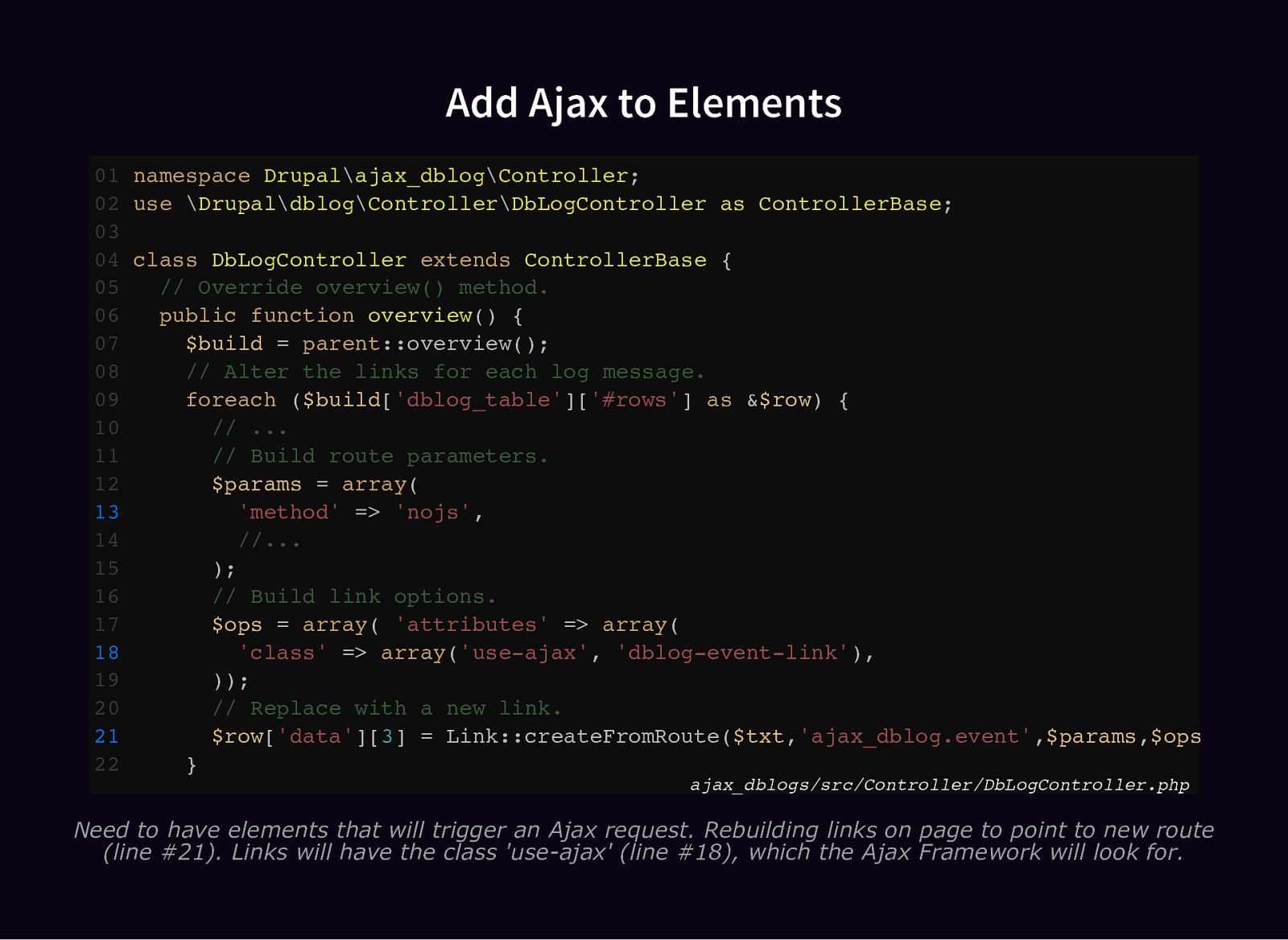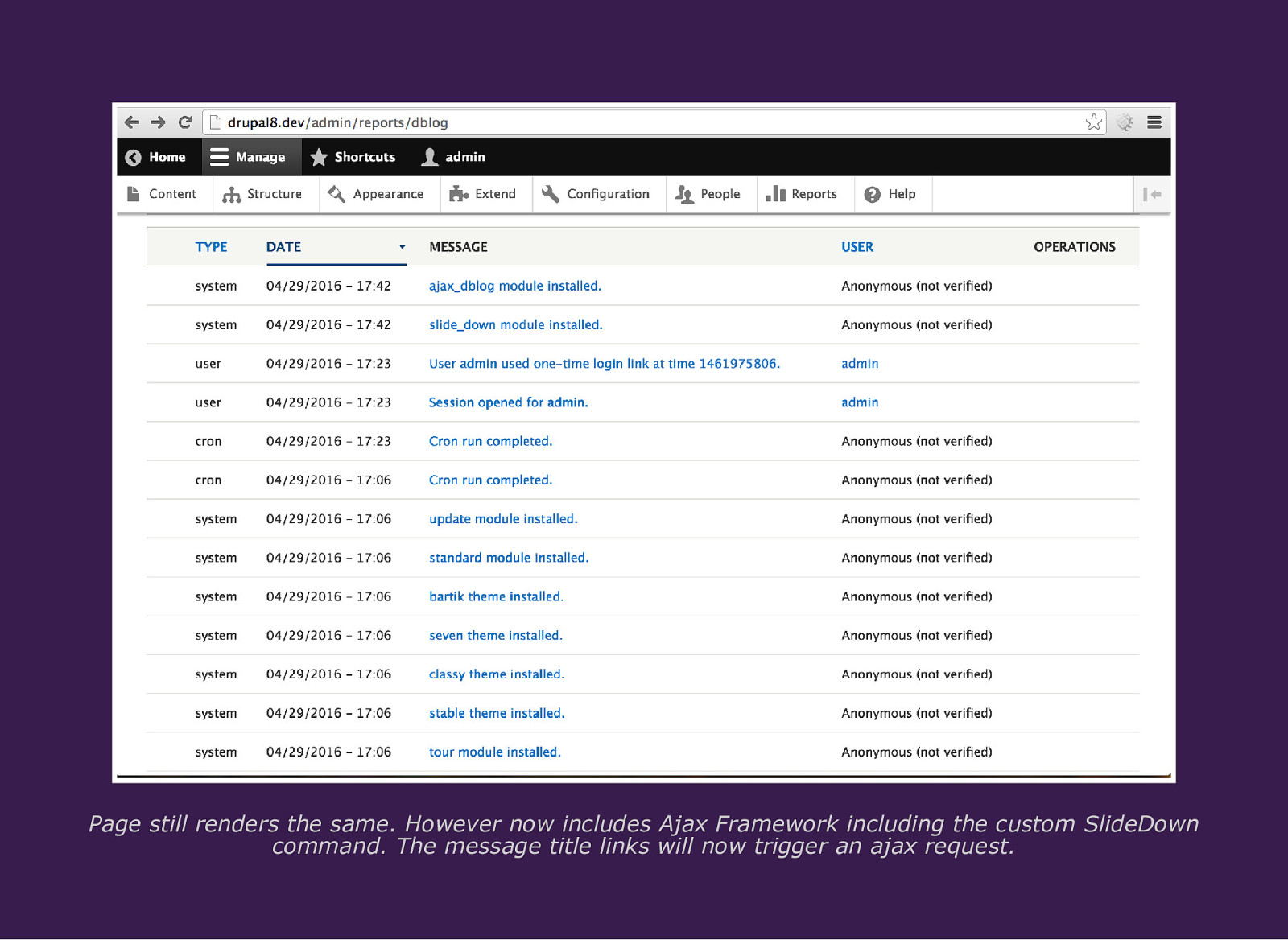Demystifying Ajax Callback Commands (in Drupal 8) events.drupal.org/node/8466 Drupalcon 2016
Slide 1

Slide 2

Mike Miles Genuine (wearegenuine.com) All the internet places: mikemiles86
Slide 3

Defining Callback Commands
Slide 4

Instructions built by the Server and executed by the Client in an Ajax event.
Slide 5

Callback Command: JavaScript Attached to ‘Drupal.AjaxCommands.prototype’ Defined in ‘misc/ajax.js’ Accepts 3 arguments: ajax response status Wrapper for additional JavaScript
Slide 6

Callback Structure: JavaScript 01 (function ($, window, Drupal, drupalSettings) { 02 ‘use strict’; 03 /** 04 * [commandName description] 05 * 06 * @param {Drupal.Ajax} [ajax] 07 * @param {object} response 08 * @param {number} [status] 09 */ 10 Drupal.AjaxCommands.prototype.[commandName] = function(ajax, response, status){ 11 12 // Custom javascript goes here … 13 14 } 15 16 })(jQuery, this, Drupal, drupalSettings); [module]/js/[javascript].js Example of the structure for the JavaScript half of a callback command as defined in a module.
Slide 7

Callback Command: PHP Class that implements CommandInterface Defines a method called ‘render’ Returns an associative array: Must have element with key of ‘command’ Value must be name of JavaScript function Other elements passed as response data
Slide 8

Callback Structure: PHP 01 namespace Drupal[module]\Ajax 02 use Drupal\Core\Ajax\CommandInterface; 03 04 // An Ajax command for calling commandName JavaScript method. 05 class [CommandName]Command implements CommandInterface { 06 07 // Implements Drupal\Core\Ajax\CommandInterface:render(). 08 public function render() { 09 return array( 10 ‘command’ => ‘[commandName]’, // Name of JavaScript Method. 11 // other response arguments… 12 ); 13 } 14 } [module]/src/Ajax/[CommandName]Command.php Example of the structure for the PHP half of a callback command as defined in a module.
Slide 9

Core Example: Remove 01 Drupal.AjaxCommands.prototype = { 02 // … 03 /** 04 * Command to remove a chunk from the page. 05 * 06 * @param {Drupal.Ajax} [ajax] 07 * @param {object} response 08 * @param {string} response.selector 09 * @param {object} [response.settings] 10 * @param {number} [status] 11 */ 12 remove: function (ajax, response, status) { 13 var settings = response.settings || ajax.settings || drupalSettings; 14 $(response.selector).each(function () { 15 Drupal.detachBehaviors(this, settings); 16 }) 17 .remove(); 18 }, 19 //… misc/ajax.js The JavaScript function for the core ‘remove’ callback command. It is basically a wrapper for the jQuery ‘remove’ method.
Slide 10

Core Example: RemoveCommand 01 namespace Drupal\Core\Ajax; 02 use Drupal\Core\Ajax\CommandInterface; 03 /** 04 * Ajax command for calling the jQuery remove() method. 05 * … 06 / 07 class RemoveCommand Implements CommandInterface { 08 // … 09 /* 10 * Implements Drupal\Core\Ajax\CommandInterface:render(). 11 */ 12 public function render() { 13 return array( 14 ‘command’ => ‘remove’, 15 ‘selector’ => $this->selector, 16 ); 17 } 18 } core/lib/Drupal/Core/Ajax/RemoveCommand.php The PHP class for the core ‘remove’ callback command. Implements CommandInterface, so it must define the method ‘render’ that returns an associative array.
Slide 11

PHP 01 //… 02 public function render() { 03 return array( 04 ‘command’ => ‘remove’, 05 ‘selector’ => $this->selector, 06 ); 07 } core/lib/Drupal/Core/Ajax/RemoveCommand.php JavaScript 01 //… 02 remove: function (ajax, response, status) { 03 var settings = response.settings || ajax.settings || drupalSettings; 04 $(response.selector).each(function () { 05 Drupal.detachBehaviors(this, settings); 06 }) 07 .remove(); 08 }, misc/ajax.js Can see how the two halfs are tied together. Value on line #4 of PHP matches JavaScript function name defined on line #2 in JavaScript. Passed CSS selector on line #5 in PHP is used on line #4 in JavaScript.
Slide 12

Callback Commands Used in all Ajax requests Composed of two parts: JavaScript function, PHP Class Provided by core and modules
Slide 13

Creating Callback Commands
Slide 14

Example Scenario Create a callback command for the jQuery ‘SlideDown’ animation
Slide 15

Create a Module 01 name: ‘Slide Down Command’ 02 type: module 03 description: Provides an Ajax Callback command for the jQuery SlideDown method. 04 package: other 05 core: 8.x slide_down/slide_down.info.yml Custom Ajax callback commands must be defined in a module.
Slide 16

Create JavaScript Function 01 (function ($, window, Drupal, drupalSettings) { 02 03 ‘use strict’; 04 05 // Command to Slide Down page elements. 06 Drupal.AjaxCommands.prototype.slideDown = function(ajax, response, status){ 07 // Get duration if sent, else use default of slow. 08 var duration = response.duration ? response.duration : “slow”; 09 // slide down the selected element(s). 10 $(response.selector).slideDown(duration); 11 } 12 })(jQuery, this, Drupal, drupalSettings); slide_down/js/slidedown-command.js Attach a JavaScript function to the AjaxCommands object provided by the Ajax Framework. Accepts the three arguments and is a wrapper for the jQuery method.
Slide 17

Create Asset Library 01 slidedown: 02 version: VERSION 03 js: 04 js/slidedown-command.js; {} 05 dependencies: 06 - core/drupal.ajax slide_down/slide_down.libraries.yml In Drupal 8 custom JavaScript files must be added to an asset library to be able to be included on a page.
Slide 18

Create PHP Class 01 namespace Drupal\slide_down\Ajax; 02 use Drupal\Core\Ajax\CommandInterface; 03 04 class SlideDownCommand implements CommandInterface { 05 // … 06 // Constructs an SlideDownCommand object. 07 public function __construct($selector, $duration = NULL) { 08 $this->selector = $selector; 09 $this->duration = $duration; 10 } 11 12 // Implements Drupal\Core\Ajax\CommandInterface:render(). 13 public function render() { 14 return array( 15 ‘command’ => ‘slideDown’, 16 ‘method’ => NULL, 17 ‘selector’ => $this->selector, 18 ‘duration’ => $this->duration, 19 ); 20 } 21 } slide_down/src/Ajax/SlideDownCommand.php Create a PHP class that implements CommandInterface. Must define a ‘render’ method and return an associative array. In the array, pass the element with key of ‘command’ and value being the name of the JavaScript function and any repsonse data.
Slide 19

To Create a Callback Command: Create a module Attach JavaScript function to ‘Drupal.AjaxCommands.prototype’ Define an asset library Create PHP class that implements ‘CommandInterface’
Slide 20

Using Callback Commands
Slide 21

Example Scenario Load watchdog log message details onto the overview page using Ajax commands.
Slide 22

Add Ajax Library to Page 01 use \Drupal\dblog\Controller\DbLogController as ControllerBase; 02 03 class DbLogController extends ControllerBase { 04 // Override overview() method. 05 public function overview() { 06 $build = parent::overview(); 07 // … 08 // Add custom library. 09 $build[‘#attached’][‘library’][] = ‘ajax_dblog/ajax-dblog’; 10 return $build; 11 } 12 // … 13 } ajax_dblog/src/Controller/DbLogController.php Need to attach custom library onto page so that custom JavaScript and Ajax Framework is included.
Slide 23

01 ajax-dblog: 02 version: VERSION 03 css: 04 component: 05 css/ajax_dblog.module.css: {} 06 js: 07 js/behaviors.js: {} 08 dependencies: 09 - slide_down/slidedown ajax_dblog/ajax_dblog.libraries.yml 01 slidedown: 02 version: VERSION 03 js: 04 js/slidedown-command.js: {} 05 dependencies: 06 - core/drupal.ajax slide_down/slide_down.libraries.yml Defining a dependency in the library on another library. The other library depends on the Ajax Framework. Drupal will follow chain to include all depended JavaScript files.
Slide 24

Add Ajax to Elements 01 namespace Drupal\ajax_dblog\Controller; 02 use \Drupal\dblog\Controller\DbLogController as ControllerBase; 03 04 class DbLogController extends ControllerBase { 05 // Override overview() method. 06 public function overview() { 07 $build = parent::overview(); 08 // Alter the links for each log message. 09 foreach ($build[‘dblog_table’][‘#rows’] as &$row) { 10 // … 11 // Build route parameters. 12 $params = array( 13 ‘method’ => ‘nojs’, 14 //… 15 ); 16 // Build link options. 17 $ops = array( ‘attributes’ => array( 18 ‘class’ => array(‘use-ajax’, ‘dblog-event-link’), 19 )); 20 // Replace with a new link. 21 $row[‘data’][3] = Link::createFromRoute($txt,’ajax_dblog.event’,$params,$ops); 22 } ajax_dblogs/src/Controller/DbLogController.php 23 return $build; Need to have elements that will trigger an Ajax request. Rebuilding links on page to point to new route (line #21). Links will have the class ‘useajax’ (line #18), which the Ajax Framework will look for.
Slide 25

Page still renders the same. However now includes Ajax Framework including the custom SlideDown command. The message title links will now trigger an ajax request.
Slide 26

Create Ajax Request Endpoint 01 ajax_dblog.event: 02 path: ‘/admin/reports/dblog/{method}/event/{event_id}’ 03 defaults: 04 _controller: ‘\Drupal\ajax_dblog\Controller\DbLogController::ajaxEventDetails’ 05 requirements: 06 _permission: ‘access site reports’ 07 method: ‘nojs|ajax’ ajax_dblog/ajax_dblog.routing.yml /admin/reports/dblog/nojs/event/123 /admin/reports/dblog/ajax/event/123 Create an endpoint that will handle Ajax Requests. The ajax framework will replace ‘nojs’ with ‘ajax’ on all request. Can use as a check to handle graceful degradation.
Slide 27

Return an AjaxResponse of Callback Commands 01 use Drupal\Core\Ajax\AjaxResponse; 02 use Drupal\Core\Ajax\AfterCommand; 03 use Drupal\Core\Ajax\RemoveCommand; 04 use Drupal\slide_down\Ajax\SlideDownCommand; 05 06 class DbLogController extends ControllerBase { 07 // … 08 public function ajaxEventDetails($method, $event_id) { 09 //… 10 if ($method == ‘ajax’) { 11 $event = parent::eventDetails($event_id); 12 $event_details = [ … ]; 13 // Create an AjaxResponse. 14 $response = new AjaxResponse(); 15 // Remove old event details. 16 $response->addCommand(new RemoveCommand(‘.dblog-event-row’)); 17 // Insert event details after event. 18 $response->addCommand(new AfterCommand(‘#dblog-event-’ . $event_id, $event_details 19 // SlideDown event details. 20 $response->addCommand(new SlideDownCommand(‘#dblog-event-details-’ . $event_id 21 } 22 // … ajax_dblog/src/Controller/DbLogController.php 23 } Have a method that is the endpoint for the Ajax request (line #8). Need to build an AjaxReponse object (line #14). Will add commands to this response using the ‘addCommand’ method and creating a new instance of the relevant Callback Command class (lines #16, #18, #20).
Slide 28

When a message title is clicked, the Ajax request is made. The endpoint builds an AjaxResponse of commands and Drupal returns a JSON string.
Slide 29

Ajax Response 01 [ 02 { 03 “command”:”remove”, 04 “selector”:”.dblog-event-row” 05 }, 06 { 07 “command”:”insert”, 08 “method”:”after”, 09 “selector”:”#dblog-event-32”, 10 “data”:”…”, 11 “settings”:null 12 }, 13 { 14 “command”:”slideDown”, 15 “method”:null, 16 “selector”:”#dblog-event-details-32”, 17 “duration”:null 18 } 19 ] The returned JSON array is parsed by Ajax Framework. Finds JavaScript function to execute and the passes the object as the data for the response argument of the function.
Slide 30

To Use Callback Commands Include the Ajax library and commands on the page. Have endpoint that returns an AjaxResponse Add commands to response using ‘addCommand’
Slide 31

Resources Drupal 8 Ajax Framework: bit.ly/Drupal8Ajax This Presentation: bit.ly/Con16Ajax Presentation Slides: bit.ly/Con16AjaxSlides Example Code: bit.ly/Con16AjaxCode Creating Commands in D8: bit.ly/D8AjaxCmds My Blog: mikemiles.com
Slide 32

Feedback @mikemiles86
Slide 33

Thank You! #DrupalCon @WeAreGenuine D8 Ajax Commands / Michael Miles